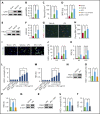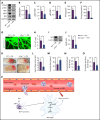Neutrophil extracellular traps promote tPA-induced brain hemorrhage via cGAS in mice with stroke
- PMID: 33881503
- PMCID: PMC8288643
- DOI: 10.1182/blood.2020008913
Neutrophil extracellular traps promote tPA-induced brain hemorrhage via cGAS in mice with stroke
Abstract
Intracerebral hemorrhage associated with thrombolytic therapy with tissue plasminogen activator (tPA) in acute ischemic stroke continues to present a major clinical problem. Here, we report that infusion of tPA resulted in a significant increase in markers of neutrophil extracellular traps (NETs) in the ischemic cortex and plasma of mice subjected to photothrombotic middle cerebral artery occlusion. Peptidylarginine deiminase 4 (PAD4), a critical enzyme for NET formation, is also significantly upregulated in the ischemic brains of tPA-treated mice. Blood-brain barrier (BBB) disruption after ischemic challenge in an in vitro model of BBB was exacerbated after exposure to NETs. Importantly, disruption of NETs by DNase I or inhibition of NET production by PAD4 deficiency restored tPA-induced loss of BBB integrity and consequently decreased tPA-associated brain hemorrhage after ischemic stroke. Furthermore, either DNase I or PAD4 deficiency reversed tPA-mediated upregulation of the DNA sensor cyclic GMP-AMP (cGAMP) synthase (cGAS). Administration of cGAMP after stroke abolished DNase I-mediated downregulation of the STING pathway and type 1 interferon production and blocked the antihemorrhagic effect of DNase I in tPA-treated mice. We also show that tPA-associated brain hemorrhage after ischemic stroke was significantly reduced in cGas-/- mice. Collectively, these findings demonstrate that NETs significantly contribute to tPA-induced BBB breakdown in the ischemic brain and suggest that targeting NETs or cGAS may ameliorate thrombolytic therapy for ischemic stroke by reducing tPA-associated hemorrhage.
© 2021 by The American Society of Hematology.
Conflict of interest statement
Conflict-of-interest disclosure: The authors declare no competing financial interests.
Figures








Comment in
-
Mechanism of ICH with tPA thrombolysis.Blood. 2021 Jul 8;138(1):8-9. doi: 10.1182/blood.2021011268. Blood. 2021. PMID: 34236426 No abstract available.
Similar articles
-
Neutrophil extracellular traps released by neutrophils impair revascularization and vascular remodeling after stroke.Nat Commun. 2020 May 19;11(1):2488. doi: 10.1038/s41467-020-16191-y. Nat Commun. 2020. PMID: 32427863 Free PMC article.
-
Daytime DNase-I Administration Protects Mice From Ischemic Stroke Without Inducing Bleeding or tPA-Induced Hemorrhagic Transformation, Even With Aspirin Pretreatment.Stroke. 2025 Feb;56(2):527-532. doi: 10.1161/STROKEAHA.124.049961. Epub 2025 Jan 27. Stroke. 2025. PMID: 39869712 Free PMC article.
-
Neutrophil extracellular traps induce barrier dysfunction in DSS-induced ulcerative colitis via the cGAS-STING pathway.Int Immunopharmacol. 2024 Dec 25;143(Pt 1):113358. doi: 10.1016/j.intimp.2024.113358. Epub 2024 Oct 9. Int Immunopharmacol. 2024. PMID: 39388893
-
Inhibition of Neutrophil Extracellular Traps: A Potential Therapeutic Strategy for Hemorrhagic Stroke.J Integr Neurosci. 2025 Apr 23;24(4):26357. doi: 10.31083/JIN26357. J Integr Neurosci. 2025. PMID: 40302254 Review.
-
Neutrophil Extracellular Traps Exacerbate Ischemic Brain Damage.Mol Neurobiol. 2022 Jan;59(1):643-656. doi: 10.1007/s12035-021-02635-z. Epub 2021 Nov 8. Mol Neurobiol. 2022. PMID: 34748205 Review.
Cited by
-
Crosstalk Among Glial Cells in the Blood-Brain Barrier Injury After Ischemic Stroke.Mol Neurobiol. 2024 Sep;61(9):6161-6174. doi: 10.1007/s12035-024-03939-6. Epub 2024 Jan 27. Mol Neurobiol. 2024. PMID: 38279077 Review.
-
The role of STING signaling in central nervous system infection and neuroinflammatory disease.WIREs Mech Dis. 2023 May-Jun;15(3):e1597. doi: 10.1002/wsbm.1597. Epub 2023 Jan 12. WIREs Mech Dis. 2023. PMID: 36632700 Free PMC article. Review.
-
The association between serum S100β levels and prognosis in acute stroke patients after intravenous thrombolysis: a multicenter prospective cohort study.BMC Med. 2024 Oct 3;22(1):304. doi: 10.1186/s12916-024-03517-6. BMC Med. 2024. PMID: 39358745 Free PMC article.
-
Neutrophil extracellular traps in homeostasis and disease.Signal Transduct Target Ther. 2024 Sep 20;9(1):235. doi: 10.1038/s41392-024-01933-x. Signal Transduct Target Ther. 2024. PMID: 39300084 Free PMC article. Review.
-
mtDNA-STING Axis Mediates Microglial Polarization via IRF3/NF-κB Signaling After Ischemic Stroke.Front Immunol. 2022 Apr 5;13:860977. doi: 10.3389/fimmu.2022.860977. eCollection 2022. Front Immunol. 2022. PMID: 35450066 Free PMC article.
References
-
- Jauch EC, Saver JL, Adams HP Jr., et al. ; Council on Clinical Cardiology . Guidelines for the early management of patients with acute ischemic stroke: a guideline for healthcare professionals from the American Heart Association/American Stroke Association. Stroke. 2013;44(3):870-947. - PubMed
-
- National Institute of Neurological Disorders and Stroke rt-PA Stroke Study Group . Tissue plasminogen activator for acute ischemic stroke. N Engl J Med. 1995;333(24):1581-1587. - PubMed
-
- Hacke W, Kaste M, Fieschi C, et al. ; The European Cooperative Acute Stroke Study (ECASS) . Intravenous thrombolysis with recombinant tissue plasminogen activator for acute hemispheric stroke. JAMA. 1995;274(13):1017-1025. - PubMed
-
- Tanne D, Kasner SE, Demchuk AM, et al. . Markers of increased risk of intracerebral hemorrhage after intravenous recombinant tissue plasminogen activator therapy for acute ischemic stroke in clinical practice: the Multicenter rt-PA Stroke Survey. Circulation. 2002;105(14):1679-1685. - PubMed
-
- Whiteley WN, Slot KB, Fernandes P, Sandercock P, Wardlaw J. Risk factors for intracranial hemorrhage in acute ischemic stroke patients treated with recombinant tissue plasminogen activator: a systematic review and meta-analysis of 55 studies. Stroke. 2012;43(11):2904-2909. - PubMed
Publication types
MeSH terms
Substances
LinkOut - more resources
Full Text Sources
Other Literature Sources
Medical
Molecular Biology Databases
Research Materials

